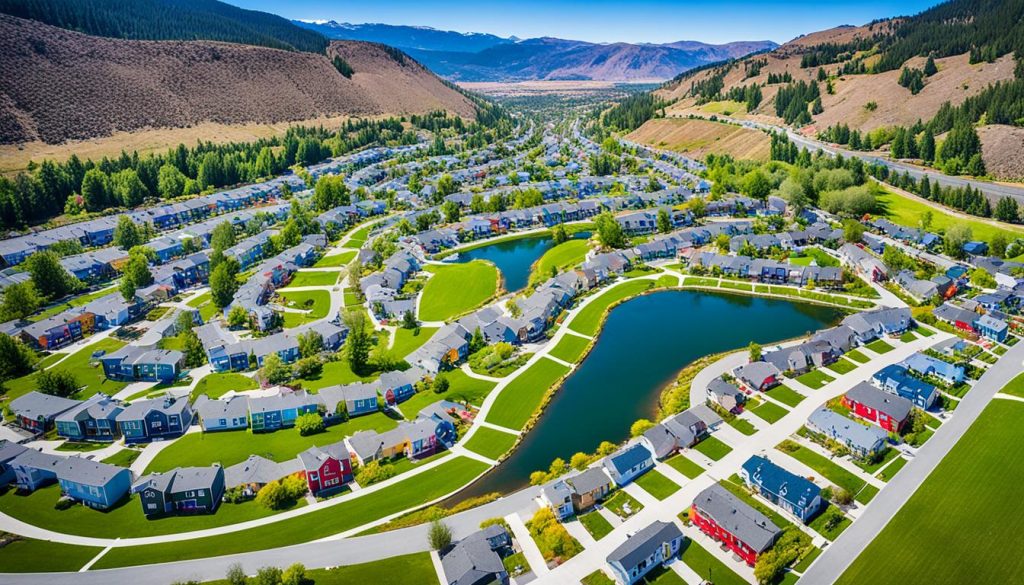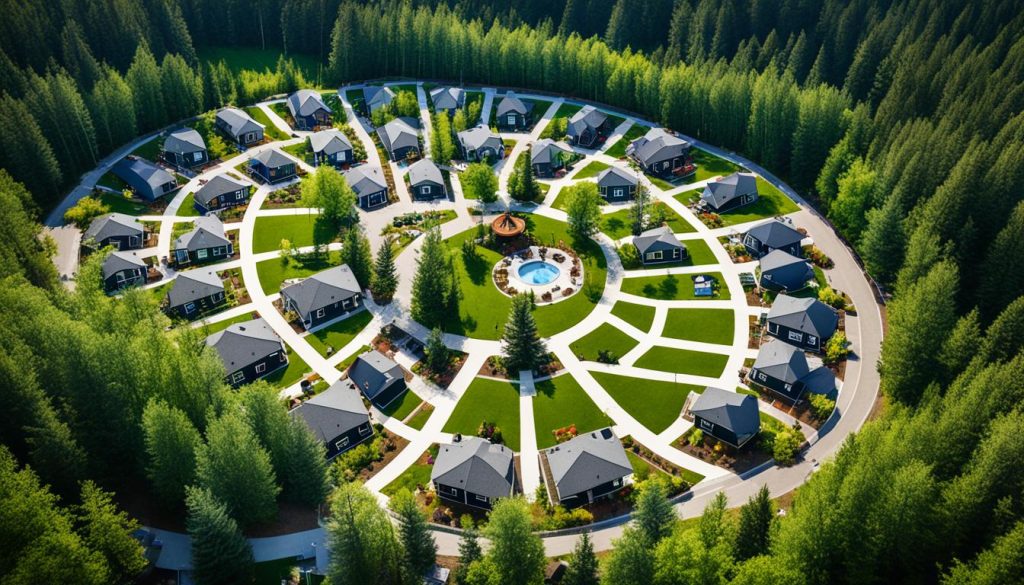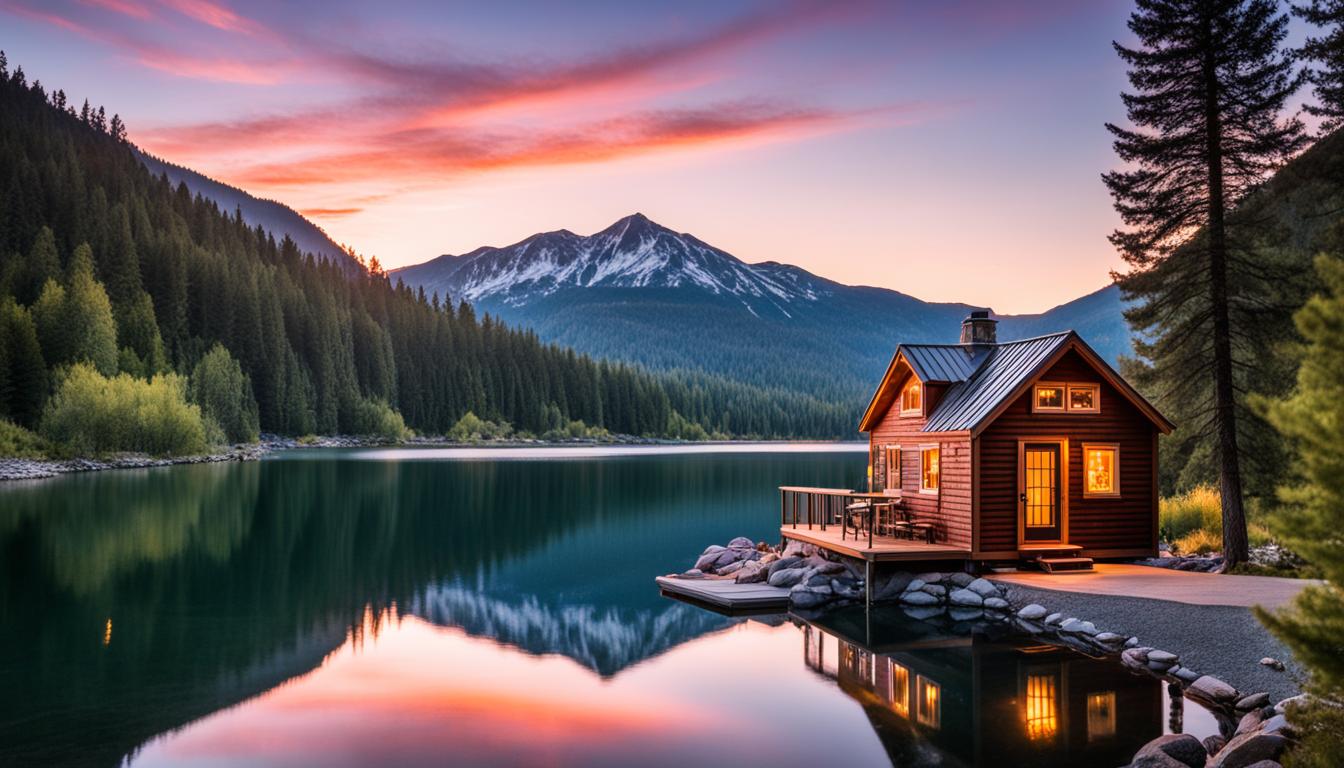Did you know that the tiny house movement has been gaining momentum in Canada? As more people seek affordable and sustainable housing options, the demand for tiny houses has skyrocketed. From small home subdivisions to year-round RV parks, Canadians are finding creative and unique places to put their tiny homes.
Key Takeaways
- There are various options available for placing your tiny house in Canada, including tiny home communities, small home subdivisions, and RV parks.
- Tiny home communities offer shared community elements and flexible living arrangements.
- Small home subdivisions require the purchase of both land and home, but may not offer shared services like traditional tiny home communities.
- Year-round RV parks provide existing infrastructure and a quick rental option, but turnover can be higher due to vacationers and temporary workers.
- Consider your preferences, budget, and long-term goals when deciding where to put your tiny house in Canada.
Tiny Home Communities with Leased Land
If you’re considering placing your tiny house in Canada, one appealing option is joining a tiny home community with leased land. These unique communities offer the perfect blend of independence and shared community elements.
In a tiny home community with leased land, you have the freedom to bring your own home while leasing a pad within the community. This arrangement allows you to enjoy the benefits of living in a community while still having the flexibility to design and personalize your own space.
One of the key advantages of these communities is the shared community element. Residents often have access to communal spaces such as gardens or shared facilities, creating a sense of togetherness and fostering a vibrant community spirit.
For those seeking a sustainable and eco-conscious lifestyle, tiny home communities with leased land provide an excellent opportunity. These communities promote environmental mindfulness, allowing residents to collectively reduce their ecological footprint and live in harmony with nature.
Examples of such communities in Canada include Big Calm in British Columbia and Robin and Ted in Ontario. These communities exemplify the ideals of tiny home living and offer a supportive environment for like-minded individuals.
Joining a tiny home community with leased land provides a unique living experience where you can enjoy the benefits of both privacy and community life. The opportunity to connect with others who share similar values and aspirations makes these communities a desirable choice for many tiny house enthusiasts.
Tiny Home Communities on Unorganized Land
Another option for placing your tiny house is to join a tiny home community on unorganized land. In these communities, individuals purchase unorganized land that does not require building permits and develop the necessary infrastructure for a tiny home community. By renting out spots for tiny homes one by one, residents can create their own unique tiny home community.
However, it’s important to note that unorganized townships are often located in remote areas. This remoteness may require residents to implement off-grid water and power plans, as these services may not be readily available in the vicinity. Additionally, due to the remote location, putting in the required infrastructure can be more expensive compared to other options.
Despite these challenges, joining a tiny home community on unorganized land offers the opportunity for individuals to establish a close-knit community and enjoy a sense of freedom and autonomy.
Tiny Home Communities with Owned Land, Condo-Style
If you’re looking for a more collective and affordable tiny home community experience, a condo-style community could be the perfect choice. In these communities, a group of owners collectively owns the land, fostering a sense of shared ownership and responsibility.
By spreading the financial burden among multiple owners, condo-style communities often offer more affordable prices compared to individually owned land. This shared ownership model also promotes a stronger sense of community and collaboration among residents.
However, it’s important to note that joining a condo-style community may require more upfront cash as you’ll be contributing to the shared ownership of the land. Additionally, navigating the paperwork and financing involved in this type of community can be more complex and challenging compared to other options.

Despite the potential challenges, condo-style communities with owned land offer a unique opportunity to be part of a close-knit community where residents have a vested interest in the success and well-being of the community.
| Pros of Condo-style Communities with Owned Land | Cons of Condo-style Communities with Owned Land |
|---|---|
|
|
Small Home Subdivisions
When it comes to finding the perfect spot for your tiny house in Canada, small home subdivisions are an option worth considering. While they may resemble tiny home communities, there are a few key differences to keep in mind.
In a small home subdivision, you have the opportunity to purchase both the land and the home. This means that you have complete ownership over your property and can customize it to your liking. However, unlike traditional tiny home communities, small home subdivisions do not offer shared services.
While there may not be shared services in small home subdivisions, there are often community amenities such as parks and green spaces. These shared spaces provide opportunities for residents to connect with their neighbors and create a sense of community.
For those who are looking for the freedom and independence that comes with owning their land and home, small home subdivisions can be a great choice. Just keep in mind that you’ll need to take care of services like utilities and maintenance on your own.
If you’re considering purchasing a small home in a subdivision, it’s important to do your research and ensure that the community aligns with your lifestyle and preferences. Take the time to visit the subdivision, speak with current residents, and assess the available amenities before making a decision.

Year-Round RV Parks
When it comes to finding the perfect spot for your tiny house in Canada, consider year-round RV parks. These parks offer an attractive option with their existing infrastructure, making it convenient for tiny house owners. With hookups, shower and laundry facilities, and power already in place, you can easily settle into these parks without the need for extensive setup.
Although year-round RV parks may not resemble traditional tiny home communities, they provide the benefit of quick pad rentals. This means you can easily secure a spot for your tiny house and start enjoying the perks of park living. Additionally, living in an RV park can offer a sense of community among the year-round residents, fostering friendships and connections.
However, it’s important to consider the potential downsides of year-round RV parks. These parks often have a high turnover of vacationers and temporary workers, which may impact the stability of the community. Depending on the specific park, this fluctuation in residents can affect the overall sense of community and may not be suitable for those seeking a more permanent living situation.

Leave a Reply
You must be logged in to post a comment.